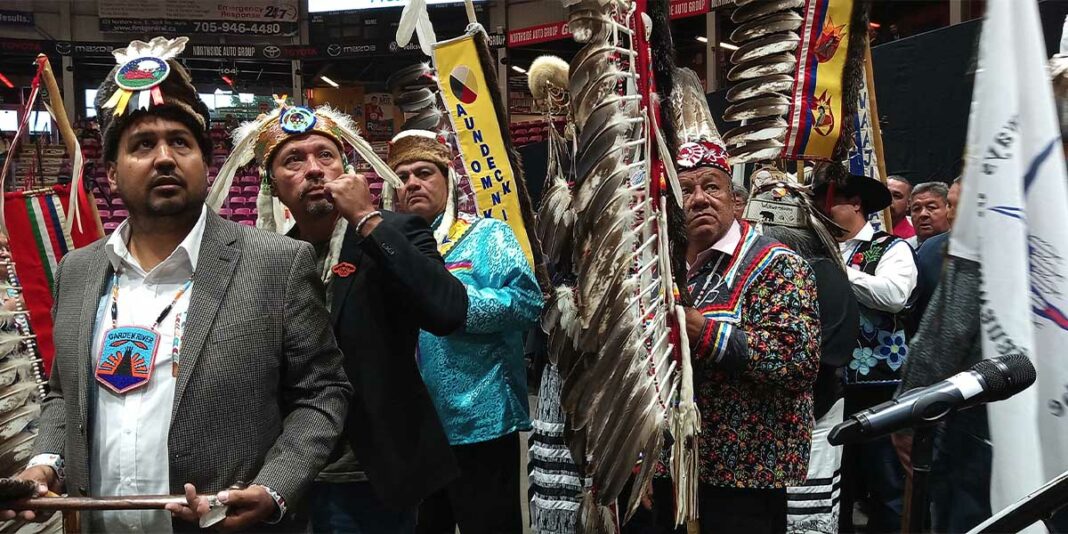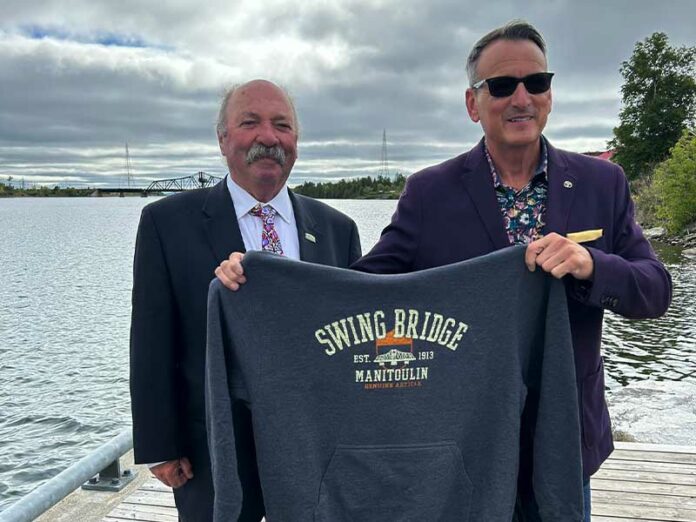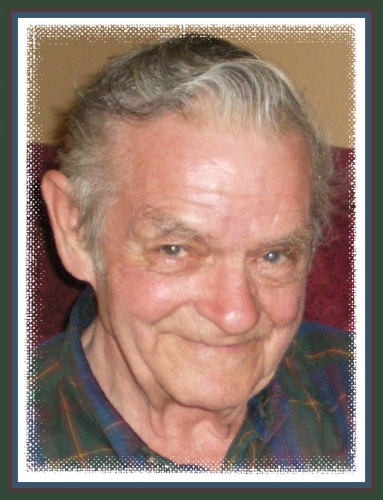Participants in weekend treaty anniversary meeting share insights
by Gina Gasongi Simon
BAWAATING—Imagine standing next to the roaring thunder of Niagara Falls in the summer of 1764, a year after King George III issued the Royal Proclamation on October 7, 1763, which laid out the principles for sovereign relations, including European settlement of Indigenous territories in parts of North America.
You can well imagine back then who held the upper hand by virtue of ‘power of the written word’ yet you can’t deny the newcomers to North America needed the Anishnaabek to survive.
A nation that did and still governs Anishinaabekeaking (the territory) in accordance with the sacred laws of Creation: a system based on principles of Respect, Responsibility, Reciprocity and Renewal of a complex web of interdependent relationships upon which all living things rely on for survival.
Now speed up to 2023 to Bawaating (Sault Ste. Marie), the site of Anishinaabe governance, where the Robinson Huron Treaty was signed on September 9, 1850. Lake Huron Anishinaabek leaders, Chiefs and Principle Men entered into treaty with the British Crown.
Leading up to the significant September anniversary date, Garden River First Nation hosted a series of workshops and teaching lodges to discuss the treaty’s history and how treaties are vital to the foundation of this country. “The treaties are recognized and affirmed within the Canadian Constitution and form part of the supreme law of the land,” stated Art Petahtegoose, host of Treaty History workshop. Others included Wampum Teachings, Sacred Bundles and various panel discussions on the ‘Political and Polical Advocacy for Treaty Implementation’ also the ‘Spirit of Intent: Ceremony and The Anishinaabe Perspective in the Annuities Case by Leroy Bennett.
Once again, the Anishinaabek Council formerly referenced as the ‘Chipaweighs at St. Mary’s’ in the 1850 RHT gathered in Bawaating (Sault Ste. Marie) to revisit the Robinson Huron Treaty (RHT) but with a new lens. This revisiting of the Robinson Huron Treaty explained Chief Angus Toulouse “is for past compensation only. A compensation that should have been paid over the last 170 years. Each of the 21 First Nations in the RHT will get a share of the proceeds from that past compensation amount.”
As explained by the litigation team the current agreement to be signed by Canada, Ontario and the Robinson Huron Treaty Anishnaabek will only be addressing the period of 1850 to the present. The Crown will continue to distribute the $4 to beneficiaries until the finalization has occurred. Right now it is still confidential and subject to the requirements of protocol and will not be share publicly.
Luckily forward thinking Anishnaabe leadership included the annuity clause in the 1850 RHT to provide for future generations. Also outlined was an agreement to share land, waters, and resources. It affirmed the Robinson Huron Anishnabek to use the unoccupied territory for harvesting and other cultural purposes. First Nations did not surrender their land, but agreed to share it.

Important to the Robinson Huron Treaty is the containment of an augmentation clause for the annuities (in this case $4) to the Treaty beneficiaries based on the revenue generated from the territory without loss to the Crown.
The annuities increased only once, rising from $1.60 to $4 in 1875. It has not changed since. When you do the math the revenues from resource extraction such as lumber (harvest trees), hydro (water driven electricity) and mining (iron, gold, diamonds etc.) from this land, those measly annuity payments do not match the promise of revenue benefits!
For generations, we had lived harmoniously on the lands stretching across the eastern shores. These lands held deep spiritual and cultural significance for us, and we cherished our connection to them. However, the British Crown, represented by William Benjamin Robinson, sought to secure these lands for the settlers’ benefit.

In the face of tremendous pressure, our chiefs and leaders reluctantly entered into negotiations with Robinson. We agreed to surrender our lands, hoping that in return, our people would receive fair treatment and protection. The treaty promised annuity payments, which were meant to provide ongoing support for our communities, education for our children, and assistance in agriculture and health care.
But the promises made to us were not fulfilled. The annuity payments were meager and inconsistent, leaving our people to face economic hardships and struggle to maintain our traditional way of life. Our lands were taken from us, and we were left to bear the burden of displacement and the loss of our cultural heritage.
This breach of the Treaty, breach of honour of the Crown and breach of fiduciary obligations by the Crown has led to these proceedings beginning in 2012.
For their part Canada recognizes the “many challenges faced by the communities, the hardships and a process that is long overdue,” stated Honourable Gary Anandasangaree, Minister of Crown-Indigenous Relations of Canada. When asked he also acknowledged, “the Indian Act was a sexist, discriminatory piece of colonialist legislation that caused irritable harm to First Nations women.” His hope for the agreement, “The First Nations will move forward in a positive way to empower their youth and the monies, however each community decides, will go toward endeavours that include education, health and economic opportunities.”
Now defining who are the beneficiaries will be part of the Office of the Mizhinawe. Margaret Simon adds to the intent of this newly formed office should be pronounced, “Mizhiwe Kina Giimok miinwa Giimok Kweok to help better understand their task. The referencing means ‘All of us—including the male and female leaders.’ For too long our women have been left out of the discussion, nor their presence acknowledged. This has to stop, if we truly want to move forward, we must keep equality and respect in balance.
The task for the office is to seek feedback from community members and make recommendations to leadership on the principles for defining beneficiary status.
The proposed settlement is viewed by many on the political front for our communities to grow, prosper and provide for a better future for our children. For many whom attended the gathering in Baawating (Sault Ste. Marie) they came to hear, understand and bear witness. The RHT process after years of deliberation and litigation, has entered a critical stage in the process. On September 8, 2023 after 170 years I went about asking how and will the $10 billion compensation serve to right a wrong?
According to Evelyn Roy from M’Chigeeng First Nation she has plans for her compensation but worries about the youth. “I would like to use my portion to fix up my house. I don’t know about the youth, I worry for them. Why is this country allowing for all the immigrants? We have young people and they need jobs. The government has to stop all this welfare; it’s not helping the people, it only teaches them to put out their hand. They need to work to understand money.”
Former councillors from Whitefish First Nation, Leona Nahwegahbow and Ester Osche echo each other’s experience. As Leona explains, “It’s not about the money, it’s about healing and unity. We must remember Mother Earth. With all the impacts of climate change, we must remain united. We have to take care of the Mother Earth, we must accept each other. And these are our teachings. You feel and hear it in the drumming, in the ceremony, we are all visiting. This is the greatest gathering that has ever taken place in our lifetime. And we felt the ancestors with us, ever since the pipes came together.” Ester adds, “It’s all about the spirit of the treaty, our feet have not touched the ground. We have been floating.”

Lorraine Bebamikwe from Wikwemikong felt she did not have enough information to make an informed decision about the proposed money. “We need time to talk and meet, not as one, but as a nation. Sure, there will be conflict and disagreement, but we need to put our heads and hearts together and eventually we will come to a decision.”
Joanne Bissiallon from Mississauga First Nation states more community liberation is warranted. “We have people who want the whole thing, all their money, but there are others who want more community consultations.” From her perspective the elders need to be respected. “Those elders have sacrificed their whole lives, living on the bare necessities, they have been the stronghold and they should be the priority for compensation first and it should be based on their age.”
There is an uptick in people who never wanted to acknowledge their ‘Indianness’ and now want to become members of First Nation communities, she noted.. “These people are only after the money, they don’t care about the community, they see dollar signs. We have to watch out for our young people, as the drug dealers will move in looking for easy prey,” Joanne added.
Another contentious issue has been the definition of entitlement and beneficiary. In the Stage 1 trial, Justice Hennesssy found the annuity was a collective amount owed to the Robinson Huron Treaty Anishnaabek. This finding was upheld by the Ontario Court of Appeal. This means that the annuity is for the collective benefit of all the RHT Anishnabek.
The compensation will be distributed to the leadership of the 21 First Nations and they will be responsible for distributing the funds. However, there is a portion that will be distributed to individuals for their own individual benefit.
While standing in the food line, I asked a young mother, Krista Manitowabi, what she would do with the money. She provided me with a very thoughtful opinion, “For me, the tool is education. If I was given that money at 20 years old, I don’t know if I would have the discipline to spend it wisely. Going to school and working for my grades taught me something about accomplishment.”
When I ask my mother what she thinks should be done with the money. She says, “We need to teach our youth about parenting. Sometimes being a young parent is tough, but it teaches you to practice stability. You become more mature in your decision-making process, as you don’t have the freedom that others have—you have to think of your child first.” When asked about her personal portion, “I would put money towards the doors at the main church to make them more energy efficient and hire someone to care for the graveyards.”
According Sam Manitowabi, “It’s going to be a long process. We still have lots of discussion and we still haven’t even touched the moving forward annuity. Some do not understand all monies cannot be dispersed, we need monies to continue the discussions and planning. Many people do not understand with money comes many needs and wants.”
As evident in the varied responses, everyone has an opinion and time to visit and discuss the wishes and desires of the collective will be as unique as each community. The future of seven generations is on the mind of Khrista Mejaki, her concern rests with the continues government cutbacks. “We need to put money in trust for the future generations. Many do not know how to handle money, it could hurt them. As for myself any amount I would be happy with, I see it as a step in the right direction if you make the proper plans. I feel for the elders, the ones who remember the language and the teachings. I have had the privilege to sit at the litigation table assisting elders and seen them tear up with emotion. They have come to the table with their hearts. They know the gift of sharing, they have fought for this all these years, if only we could learn to fight ourselves.
Newly-minted M’Chigeeng Chief Morgan Hare thought more concrete information would be shared and a date would be set for the final signing of the agreement by the Canadian government. He also noted, “Sometime within the next few weeks we will receive word from the government for a date in November. I have to go back to my community and present to my council so we can prepare ourselves for when the litigation team comes to present information and more details. After that happens, we will be able to engage the community, present the information to members of M’Chigeeng so we’re all well informed and get some feedback.
For Wiikwemkoong’s Chief, Rachel Manitowabi, she would like to see a unified front. “On behalf of Wiikwemkoong because we have both treaty and non-treaty members, the RHT will be a challenge to recognize the past wrongs and how to make them right. This issue has helped us look ahead in a more unified way, that we are one community. And I will ask the community to stay united, do not let this divide us, we are Wiikwemkoong, we are one, all of us. I am proud we have Ojibwe, Odawa and Pottawatomi, the Three Fires Confederacy. Let us keep the fire burning. Let’s treat each other equally.”
Without the final signature on the page from Canada, which is promised when parliament resumes, the 21 First Nations signatories to the Robinson Huron Treaty will wait in anticipation, while preparing to move forward onto community consultations, seeking input and direction from their citizens.





